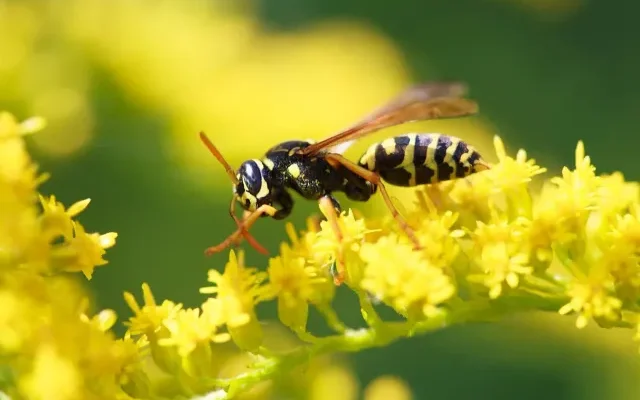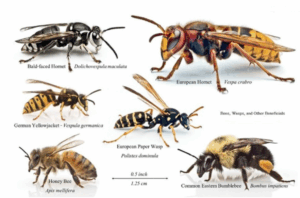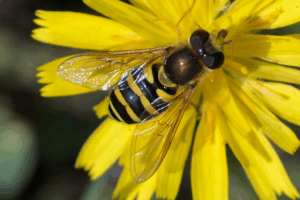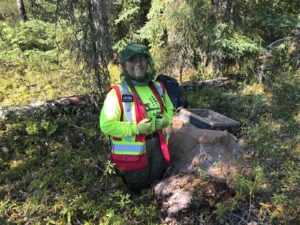Buzz Off! Everything You Need to Know About Wasps

Wasps – we know them, we dodge them, and after last summer’s waspageddon, we’ve got some serious trust issues. Whether you’re elbow-deep on a hike or just trying to enjoy a patio drink in peace, now’s the time to brush up on your survival tactics with these simple tips to stay sting-free (and maybe make peace with these little buggers).
Why We Love to Hate Wasps
Wasps often get written off as aggressive jerks, especially compared to their gentler bee cousins. And to be fair… they kind of are. If you’ve ever had to abandon your lunch because one wouldn’t stop circling your sandwich, you know what we mean. But as much as we’d like to hold a grudge, they do play an important role in the ecosystem as pollinators, so they earn a sliver of forgiveness. Reluctantly.
Types of Wasps: Social vs. Solitary
With over 4,000 wasp species identified in North America alone, they can be tricky to tell apart. Wasps are generally grouped into two categories: solitary or social. Solitary wasps tend to mind their own business. Social wasps, like yellow jackets, paper wasps, and hornets, are the ones you’re more likely to cross paths with (and potentially offend).
These social types live in colonies, which makes them especially territorial. If you wander into their zone, they won’t just give you a warning buzz—they’ll swarm, and suddenly you’ll find yourself the target of group effort.
How to Identify Common Types of Wasps

When wasps are waging war against you, identifying the enemy probably isn’t your top priority, getting out of there is. But if you or someone on your crew has an allergy (or you’re just curious about what got you), it helps to know who’s who. The better you can identify them, the better chance you have of avoiding their nests altogether.
Hornets
There are lots of hornet species out there, and they vary quite a bit, but in general, hornets are the biggest of the bunch. They’re usually hairless, black with white markings, and noticeably larger than yellow jackets or paper wasps. That size? It’s your main clue.
Hornets build paper nests in sheltered spots like tree branches or dense shrubs. They’re also known for being extra aggressive, and their stings pack more punch than most. If you spot one, best to give it space (and maybe a little respect).
Yellow Jackets
Out of the bunch, yellow jackets are the easiest to recognize, and the quickest to take offence. They’ve got short legs, black antennae, and bold yellow stripes running down their bodies.
They build paper nests too, but usually in hard-to-see places like hollow logs, deadfall, or underground cavities. That makes them the hardest nests to spot, and the easiest to stumble into. If you’re going to get stung by surprise, odds are a yellow jacket’s behind it.
Paper Wasps
Paper wasps are slimmer than yellow jackets, with longer legs and a more muted brownish colour marked with yellow. And their nests? You guessed it, paper. They’re made from a mix of chewed-up wood and saliva (yes, wasp spit and all).
Like hornets, paper wasps like to build their nests in tree branches and shrubs. But if you’re closer to home, check the eavestroughs, porches, and door frames. They’re big fans of sheltered spots. But wherever you are, it’s worth giving the area above you a quick scan.
Imposter!

There’s one more bug you might spot that looks suspiciously like a yellow jacket, but isn’t. Meet the hoverfly.
At first glance, it wears the same black-and-yellow stripes, but before you go into swat mode, take a closer look. Hoverflies differ in wing shape, body structure, and (true to their name) how they fly. Their wings are more like a horsefly’s, and instead of darting around erratically, they hover in place like a tiny drone.
Once you know the signs, it’s pretty easy to tell them apart. And the best part? Hoverflies are harmless. Just curious little pollinators doing their thing, no stingers, no drama.
What Attracts Wasps?
Scents
Wasps have a strong sense of smell, and they’re not picky. Meat, fruit, sugar, anything you’re enjoying on a nice day outside is fair game. If it smells good to you, it probably smells even better to them.
That includes your lunch and your drink. Keep your food covered and give your beverage a quick check before taking a sip. Wasps have a habit of slipping into open cans when you’re not looking.
It’s not just food, either. Colognes, perfumes, scented lotions, and even fruity shampoos can draw them in. If you’re heading into the field (or just planning to spend time outdoors), consider swapping your products for unscented ones—or at least skip the spritz. Your future sting-free self will thank you.
Just like certain smells can attract wasps, others can help keep them at bay. There are plenty of DIY repellents you can use around the yard, but if you’re working in industry, some of these scents can actually be worn.
Here are a few scents that wasps tend to avoid:
- Peppermint Oil
- Citrus
- Cloves
- Lavender
- Thyme
- Citronella
Bright Colours
Wasps are pollinators, and like most pollinators, they’re drawn to bright, flower-like colours. So if you’re rocking vibrant clothing, don’t be surprised if a wasp mistakes you for a bouquet and decides to get a little too close. You might even pick up an admirer (not the fun kind, unfortunately).
If you can, avoid ultra-bright colours when spending time outdoors. But if you’re in high-visibility clothing for work, staying still is your best defence. Swatting only makes things worse. Take a breath, keep calm, and let your “admirer” move along. It might sting a little, but you’ll move on.
Wood
Wasps love wood, but not in the way you might think. They’ll chew it up, mix it with a bit of spit, and turn it into the papery material they use to build their nests. Charming, right?
If you’re in a yard or work area with a lot of untreated wood, it’s free real estate. Keep an eye out for signs of damage, and when possible, seal or paint exposed wood to make it less appealing.
And in the forest? Deadfall is a favourite wasp hangout. Try to avoid stepping on or over it if you can. Easier said than done when bushwhacking, but worth the effort if it helps you steer clear of a nest.
Stung? Here’s What to Do

Wasp stings are painful, there’s no getting around it. But not all reactions are the same. Some fade quickly, while others stick around a bit longer (and with more drama). Here’s how to tell the difference, and what to do next.
Normal Reaction
A normal reaction typically includes swelling, redness, and a visible centre point where the wasp stung. The pain usually recedes within 1–2 hours.
Large Local Reaction
More intense swelling (sometimes spreading several centimetres beyond the sting), redness, and discomfort that can last 2–3 days or longer. It’s not dangerous, just more dramatic.
These reactions can be treated by:
- Washing the area with soap and water
- Applying a cold compress
- Using Polysporin at the sting site to prevent infection
- Taking antihistamines to reduce itchiness, as well as Advil or Tylenol to help manage pain
Severe Reactions (Anaphylaxis)
In rare cases, stings can trigger anaphylaxis, a serious allergic reaction. Symptoms include:
- Difficulty breathing due to throat swelling
- Coughing and wheezing
- Hives on all areas of the body
- Lightheadedness
- Severe swelling of the lips and face
If these symptoms occur, or if two systems of the body (like skin and breathing) are affected, you must administer epinephrine using an EpiPen and call 911 or go to the Emergency Room.
If you’re working in the field or a remote environment and you’re not sure whether you’re allergic, consider taking an allergy test and purchasing an EpiPen just in case (or multiple, as they only last about 15 minutes). It’s also recommended that you notify your employer and your crew of your allergy, where your EpiPen is located, and ensure everyone on the crew knows how to use one.
Long-term treatment for a wasp allergy is called allergen immunotherapy. If you or someone you know is allergic, consider talking to a physician about it.
Post-Sting Prevention
When a wasp stings, it releases a pheromone that signals the rest of the colony to attack. That chemical marker can cling to your clothing for days if it’s not washed out properly. If you’re working in the field and re-wearing gear that’s already been through a sting incident, you might be setting yourself up for round two.
To lower your chances of another run-in, wash your clothes with warm water and soap as soon as you can. If you’re doing shift work (like we do), that might mean tossing a load in at the hotel, or doing a quick rinse in the tub.
Resources
Curious, cautious, or just not in the mood to get stung again? Here are some solid reads to keep in your back pocket:
- Wasp basics
- Why wasps get aggressive
- How to identify wasps
- Tips for getting rid of wasps
- Natural repellent methods
- Keeping wasps away from home
- What foods attract (or repel) wasps
- How to treat a wasp sting
- Remedies and when to seek help
Last Buzz on the Matter
Getting stung? Hard pass. It hurts, and if you’re allergic, it can turn serious fast. These tips won’t make you invincible, but they’ll definitely stack the odds in your favour.
Being able to recognize wasps, avoid their nests, and cut down on the things that attract them won’t just help you out, it can make the whole crew safer. Whether you’re out bushwhacking, working the line, or just loading up for the day, a little wasp awareness goes a long way.
Stay sharp, stay calm, and try not to look too much like a snack. 😉
Written by Emily Scott


